Japan
Wood Products Prices
Dollar Exchange Rates of 25th
September
2025
Japan Yen 149.51
Reports From Japan
BoJ policy rate unchanged
On 19 September the Bank of Japan (BoJ) policy board
voted unanimously to start selling a tranche of exchange-
traded funds (ETF) and Japan real estate investment trusts
causing a dip in the stock index and a strengthening of the
yen.
The BoJ started purchasing ETFs in 2010 as part of its
aggressive monetary easing programme to fight deflation.
The Bank decided in March 2023 to end new purchases
and has since been examining how to conduct the disposal.
In related news, the BoJ kept its key policy rate unchanged
at 0.5% amid uncertainty related to tariffs and domestic
politics.
Consumer inflation in August was 2.7%, down from 3.1%
in July and below expectations. Core consumer inflation
was also 2.7%, the first time below 3% in nine months but
still above the BoJ's 2% target. Inflation, excluding fresh
food and energy seen by the BoJ as better reflecting the
underlying inflation trends, was 3.3%.
See:
https://www.japantimes.co.jp/business/2025/09/19/economy/ban
k-of-japan-september-
rates/?utm_source=pianodnu&utm_medium=email&utm_campai
gn=72&tpcc=dnu&pnespid=8pkfj4el4qwxovi8oql2r.dn9b4o.taqh
qckak04veevywrezhcaiqakxkilxbbwiro_bq
Machinery order sentiment indicator slides
The total value of machinery orders received by 280
manufacturers operating in Japan decreased by 4% in July
from the previous month on a seasonally adjusted basis
signaling these companies view on business prospects
dimmed.
Private-sector machinery orders, excluding volatile ones
for ships and those from electric power companies,
decreased a seasonally adjusted by almost 5% in July.
See: https://www.esri.cao.go.jp/en/stat/juchu/juchu-e.html
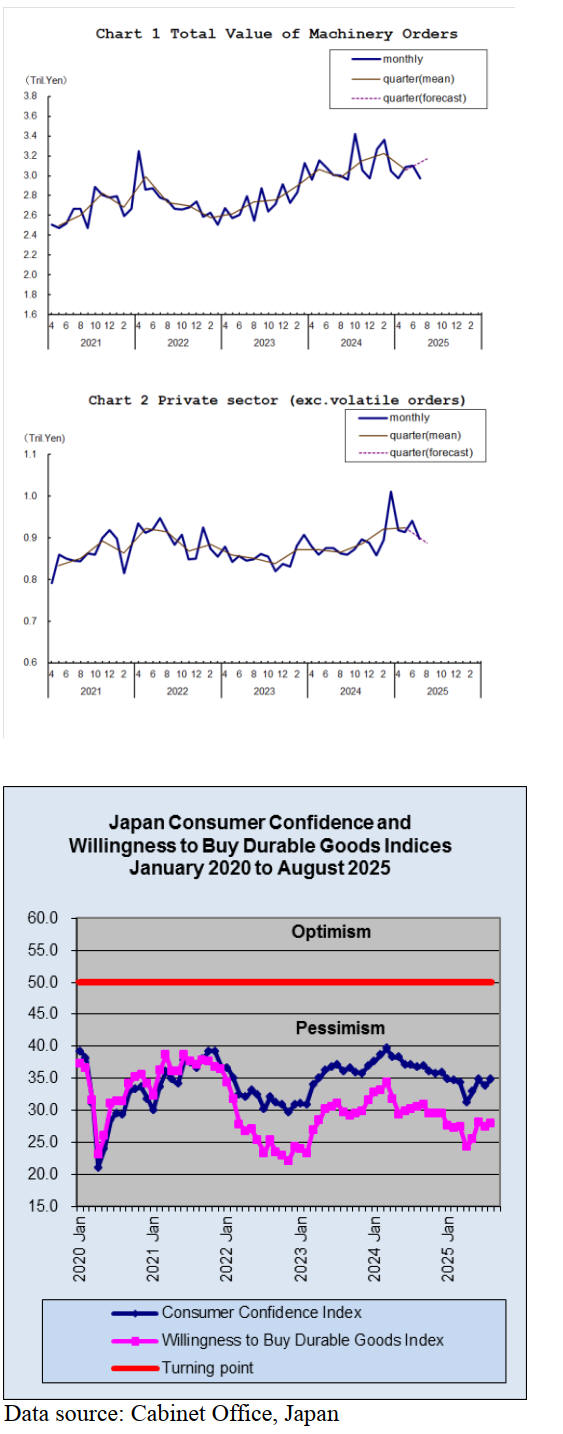
Yen dipped to 2-month low against dollar
The Japanese yen weakened against other major currencies
in late September following the release of lower than expected overall
inflation.
Data from the Ministry of Internal Affairs and
Communications showed that overall inflation (in the
Tokyo region, the inflation yardstick) was up 2.5% year on
year in September. That was below of expectations for an
annual increase of 2.6%. The BoJ basis for additional
interest rate increases has been made more difficult by the
fall in inflation.
See: https://asia.nikkei.com/business/markets/currencies/yen-
dips-to-2-month-low-against-dollar-as-investors-bet-on-longer-boj-pause
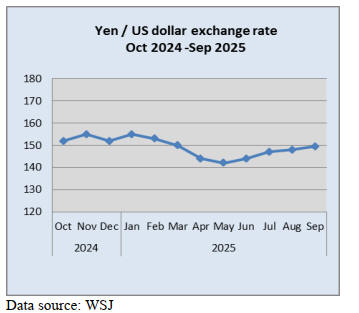
Home construction costs up 30% over past five years
House prices in Japan are soaring. The cost of constructing
homes is rising and the Ministry of Land, Infrastructure,
Transport and Tourism reported that, as of July, land
prices had risen for the fourth consecutive year which is
pushing up real estate prices.
A government survey has shown construction costs have
increased by about 30% over the past five years. Low-
interest rates and the weak yen have spurred real estate
transactions by affluent individuals and foreign investors
which has exacerbated the supply-demand balance. While
the population declines and vacant homes increase prices
of homes continue to rise.
See:
https://mainichi.jp/english/articles/20250922/p2a/00m/0op/007000c
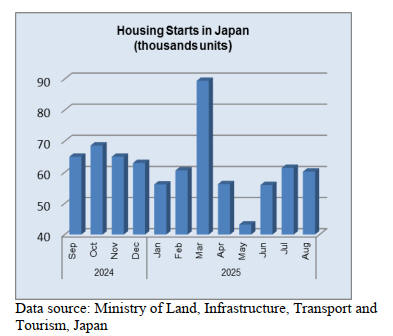
Foreign trainee programme overhaul
The Japanese government has decided to replace the
controversial foreign trainee programme in 2027 with a
new system aimed at improving rights protections,
offering increased flexibility for job changes and
implementing tougher oversight.
Under the new legislation, foreign workers will be allowed
to change workplaces within the same industry under
certain conditions, marking a turnaround from the existing
programme that prohibited job transfers. Under the new
programme for training and securing labour Japan will
accept foreign workers in 17 industries, including
construction and farming which face severe labour
shortages.
See:
https://mainichi.jp/english/articles/20250926/p2g/00m/0na/047000c
Furniture import update
The furniture market in Japan was valued at around US$23
million in 2024 and is projected to reach US$26.32 million
by 2032. The Japanese furniture market is a mature and
sophisticated sector influenced by the country's unique
cultural heritage, urban living conditions and a strong
emphasis on quality and design.
Japan's aging population is a significant driver of furniture
market trends, particularly for products that cater to the
needs of older adults. Ergonomic and functional furniture
designed to support mobility and comfort is in high
demand. The high level of urbanisation in Japan has led to
an increase in smaller living spaces. This drives the
demand for space-saving, multifunctional and compact
furniture.
Home furniture accounts for the largest market share
driven by rising disposable incomes and focus on home
interiors. Office furniture demand is growing steadily due
to increasing demand for ergonomic and functional
workstations. Hospitality furniture is expected to expand
with the growing tourism industry.
See: https://www.datainsightsmarket.com/reports/japan-furniture-market-6703#summary
and https://www.renub.com/japan-furniture-market-p.php
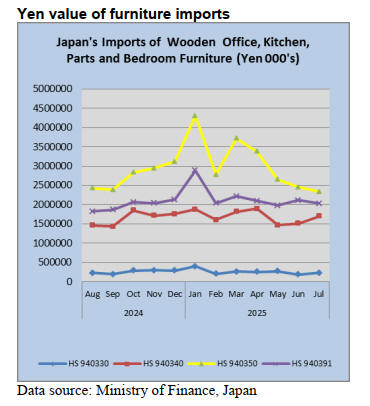
Wooden office furniture imports (HS940330)
Three shippers accounted for over 92% of July arrivals of
wooden office furniture (HS940330). The other main
source of wooden office furniture imports was EU
member countries along with Canada and the US.
In July, shippers in China accounted for 79% (90% in
June) of Japan’s imports of wooden office furniture the
other significant sources were Malaysia (9%) and Turkey
(4%). The value of July imports from Indonesia and the
US were significantly higher than in June and imports
from Italy in July were around the same level as in June
while the value of July imports from Viet Nam was at
around the same level as in June.
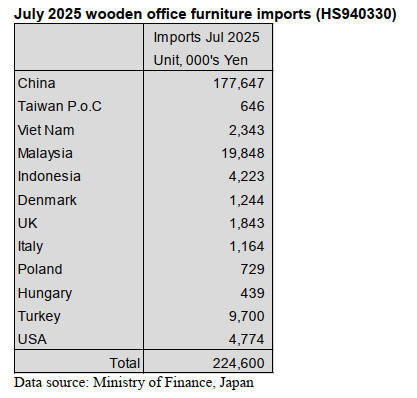
Year on year, the value of Japan’s imports of wooden
office furniture in July was around the same level but
compared to a month earlier the value of imports rose.
Wooden kitchen furniture imports (HS940340)
As in previous months July imports of wooden kitchen
furniture (HS940340) were dominated by shippers in the
Philippines (53% of HS940340 imports) and Viet Nam
(25% of HS940340 imports). July arrivals from the
Philippines and Viet Nam were up month on month. The
value of July arrivals from China was below the value
reported for June. There was a decline in imports from
Italy in July after the substantial June arrivals.
Year on year there was a 10% rise in the value of wooden
kitchen furniture and there was a significant rise in the
value of July imports compared to a month earlier.
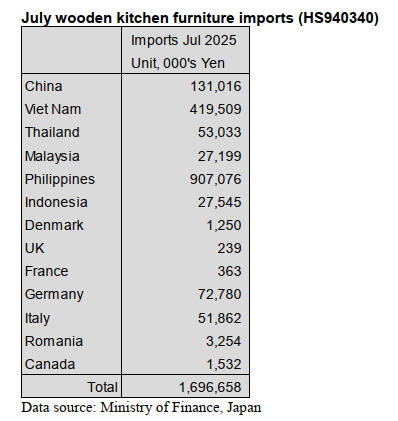
Wooden bedroom furniture imports (HS940350)
The downward trend in the value of wooden bedroom
furniture imports into Japan continued in July. The value
of July 2025 imports was 5% below that reported for June
and over 16% below the peak of imports in February.
The top two shippers of HS940350 to Japan in July were
China, 64% of the total but this was down month on
month and Viet Nam 29%, a slight increase month on
month. Malaysia maintained a share of imports at 2.5%
(down from 4% in June). The other main sources of July
imports were Indonesia, Italy and Poland.
Year on year there was an 18% decline in the value of
wooden bedroom furniture in July and compared to June
there was also a decline.
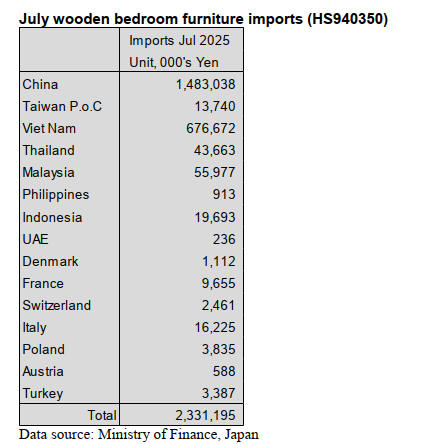
Wooden furniture parts imports (HS940391)
Apart from the spike in the value of wooden furniture
parts (HS940391) imports in January the monthly value of
imports remained steady during the first seven months of
2025.
The value of July 2025 imports was slightly lower (4%)
than reported in June and compared to July 2024 there was
a 12% decline in the value of imports. Shippers in China,
Indonesia and Viet Nam accounted for most (76%)
HS940391 imports in July 2025. The value of imports
from China rose month on month while import values
from Viet Nam dropped compared to June.
Of the total value of HS940391 imports, 46% was
delivered from China (41% in June) 18% from Indonesia
(19% in June), 12% from Viet Nam (11% in June).
Malaysia, which secured an 11% share of July imports,
was the forth ranked source in terms of the values. Imports
of HS940391 from Italy, Germany and Hungary rose in
July but for Taiwan P.o.C and South Korea there was a
decline in the value of imports.
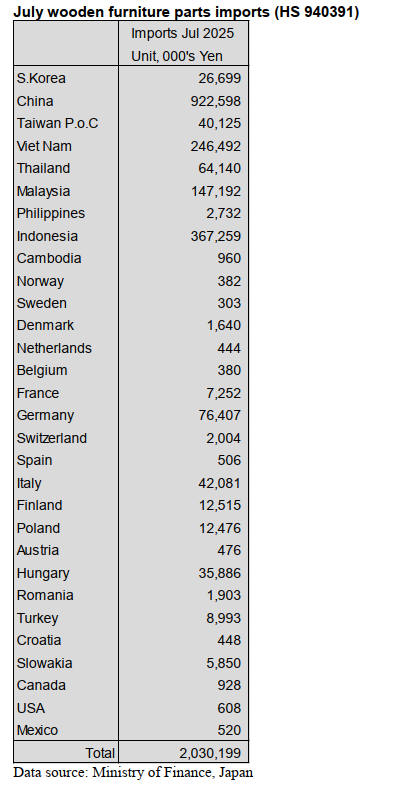
Trade news from the Japan Lumber Reports (JLR)
The Japan Lumber Reports (JLR), a subscription trade
journal published every two weeks in English, is
generously allowing the ITTO Tropical Timber Market
Report to reproduce news on the Japanese market
precisely as it appears in the JLR.
For the JLR report please see: https://jfpj.jp/japan_lumber_reports/
Wood exports during the first half of 2025
Volume of exported logs during January to June, 2025 is
1,033,781 cbms, 21.7 % more than January to June, 2024.
Volume of exporting lumber during January to June, 2025
is 98,179 cbms, 37.4 % more than the same period last
year. The increase has continued for three consecutive
years in logs, and for two consecutive years in lumber.
Despite the impact of the U.S. tariff policy against China
and tighter domestic supply and demand conditions, log
exports increased at a pace surpassing the previous year.
Log exports to China totaled 942,854 cbms, up 25.1%
from the same period last year. Exports to South Korea
reached 59,038 cbms, an increase of 6.9%, while exports
to Taiwan were 29,646 cbms, down 21.4% year-on-year.
Total volume of cedar is 930,962 cbms, 25.0 % increased
and of cypress is 92,625 cbms, 11.8 % increased from the
same period last year.
The total volume of lumber exported to China was 34,704
cbms, an increase of 15.9% compared to the same period
last year. Exports to the U.S. reached 29,172 cbms, up
43.8%. Shipments to the Philippines totaled 15,436 cbms,
a sharp rise of 125.4%. Exports to Taiwan were 11,692
cbms, up 41.5%, and to South Korea, 4,672 cbms, an
increase of 21.0%.
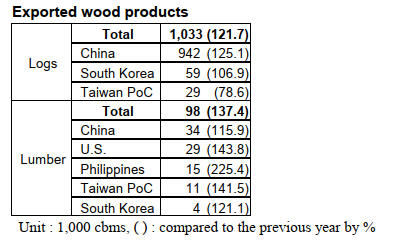
Japan’s log exports to China in June
Log export to China in June, 2025 is 177,413 cbms and
this is 20.0 % more than June, 2024.
However, when looking at individual ports, shipments
from Shibushi Port in Kagoshima Prefecture—which had
previously been a major export hub—have slowed down.
Exports of raw logs to China from the port dropped from
around 44,000 cbms in April and May, 2025 to 33,827
cbms in June, 2025, marking a decrease of approximately
10,000 cbms.
Due to the impact of US tariffs exports of cedar lumber
from China to the United States appear to have been
affected. This supports observations by raw log exporters
in Kyushu, who report a decline in inquiries from Chinese
manufacturers.
Although demand from Chinese manufacturers exporting
cedar lumber to the United States has weakened, inquiries
from domestic manufacturers supplying construction and
civil engineering materials within China remain steady.
Prices of Japanese cedar logs exported to China softened
at the beginning of the year due to concerns over Trump-
era tariffs, but have since remained stable. Domestic prices
for cedar logs intended for export have remained generally
stable. In Kyushu, where demand has stagnated, reduced
inquiries from China have enabled exporters to meet their
log requirements through direct shipments from forest
owners to ports.
Consequently, the need to procure supplementary volumes
from local log markets has declined, exerting downward
pressure on prices for lower-grade timber in the region.
Currently, the price of 4-meter cedar logs for export
remains slightly above ¥10,000 delivered to port, per cbm,
only ¥500 to ¥1,000 lower than this spring.
In regions such as Tohoku, port-delivered prices have
remained flat. Amid rising truck transportation costs, raw
material producers are increasingly prioritizing shipments
to nearby ports over deliveries to large, distant mills.
Japan to revise JAS labeling standards for wood products
The New Business and Food Industry Department of the
Minister's Secretariat at the Ministry of Agriculture,
Forestry and Fisheries will completely prohibit the use of
manually stamped JAS marks.
Triggered by last year's scandal involving unauthorised
use of the JAS mark, the labeling method will be revised
to a system that allows usage tracking through inkjet
printing or stickers. Stricter regulations on the application
of the JAS mark are scheduled to be discussed at this
summer’s JAS Standards Committee, with implementation
expected as early as around next summer.
For nine product categories—lumber, glued laminated
timber, CLT, LVL, structural panels, plywood, flooring,
2x4 lumber, and wood pellet fuel—the authorities have
called for clearer labeling of business operator information
on JAS-certified products, as well as harmonisation of
standards across different specifications. In cases where
the business entity displayed on a JAS-certified product is
not a certified operator, such as an importer, it will be
mandatory to include the certification number of the
relevant certified operator associated with the product.
The labeling of business operator information will be
revised, and the methods for indicating grades and other
specifications will also be clarified and standardised.
As part of this revision, the use of hand-stamped JAS
marks will be prohibited, and labeling methods will be
replaced with systems that allow usage tracking, such as
inkjet printing, laser marking, or stickers with quantity
control.
Under the revised labeling rules for forest products, all
items except raw materials such as plywood and lumber
will be subject to the changes. Since glued laminated
timber, plywood, and lumber have already adopted inkjet
printing, trackable roller stamps, or sticker-based labeling,
they are considered relatively well-prepared for the
transition.
At this stage, the items of concern include lumber not
classified under mechanical grading and single-layer
flooring, which are generally produced by small-scale
businesses. These operators often face difficulties in
securing funds for new equipment investments such as
inkjet labeling systems.
However, since last summer, the Ministry of Agriculture,
Forestry and Fisheries has been explaining the basic policy
for label revisions to domestic and international registered
certification bodies. It also appears to have provided
technical briefings during a liaison meeting held this
January. Between last December and this January, industry
associations related to JAS-certified products were also
briefed on the labeling revisions.
The Ministry considers that awareness of the changes has
been steadily progressing. According to the Ministry of
Agriculture, Forestry and Fisheries, it will formally
request that registered certification bodies either take
responsibility for collecting previously used hand-stamped
JAS marks or obtain a certificate of disposal.
U.S. tariffs
The Forestry Agency has released information regarding
the status of wood-related issues under U.S. tariff policy.
It was confirmed that the reciprocal tariffs implemented
from August 7 do not apply to certain items, including
wood products (such as logs, lumber and plywood),
pharmaceuticals, and semiconductors.
Japan's tariff rate has been set at 15%, but the list of
exempted items will generally follow the provisions of the
presidential order issued on April 2. In the case of wood-
related products, items such as logs, lumber, and plywood
are excluded from the tariffs.
On the other hand, new reciprocal tariffs will apply from
August 7 to items such as wooden fittings, other wood
products (including bamboo), and wooden tableware. In
2024, exports to the United States included ¥800 million
worth of “other fittings,” such as wooden fittings, ¥300
million of “other wood products” including bamboo items,
and ¥300 million of wooden tableware. These items,
which are relatively highly processed, are subject to tariffs
under the current policy.
It remains unclear at this point whether the 15% tariff will
be added on top of existing duties for items subject to
reciprocal tariffs, or whether it is included within the 15%.
Plywood
Domestic softwood plywood saw particularly sluggish
movement toward the end of August. Although
manufacturers continued to push for price increases in July
and August to improve profitability, actual demand
remained weak, resulting in flat price trends. Therefore,
the price of 12 mm 3 x 6 domestic structural softwood
plywood is 1,090 – 1,100 yen, delivered per sheet.
Meanwhile, major plywood manufacturers have
announced further price increases for September,
indicating that they are unwilling to sell below ¥1,100.
The movement of imported South Sea plywood has been
somewhat sluggish. Despite expectations of rising
domestic prices driven by higher source-country prices for
mainly 12mm thick products and the weaker yen buyers
continue to make purchases only as needed.
The price of 12 mm 3 x 6 coated formwork plywood is
1,800 – 1,850 yen, delivered per sheet. Standard formwork
plywood is around 1,550 yen, delivered per sheet.
Structural plywood is around 1,550 yen, delivered per
sheet. 2.5 mm plywood is around 780 yen, delivered per
sheet. 4 mm plywood is around 930 yen, delivered per
sheet. 5.5 mm plywood is 1,100 yen, delivered per sheet.
Price increases have been observed at the production
sources for 12mm thick plywood from Malaysia and
Falcata combination plywood from Indonesia. At the point
of origin, 12 mm 3 x 6 coated formwork plywood is
US$600 –610, C&F per cbm. Standard formwork plywood
is US$500 – 510, C&F per cbm. Structural plywood is
US$510 – 520, C&F per cbm.
In Indonesia, 2.4 mm 3 x 6 plywood is US$970, C&F per
cbm. 3.7 mm 3 x 6 plywood is US$880, C&F per cbm. 5.2
3 x 6 plywood is US$850, C&F per cbm.
Cedar logs for China
Export prices of Japanese cedar logs to China are on a
downward trend. The easing of domestic log supply and
demand in China is behind the trend.
Currently priced at US$102–103, C&F per cbm, the rate is
USD 13–15 lower than at the beginning of the year,
causing many exporters to face negative margins. The
cumulative volume of log exports to China—primarily
Japanese cedar— reached 942,854 cbms by the end of
June 2025, marking a 25.1% increase compared to the
same period last year and significantly surpassing the
previous record high. However, the export environment is
not necessarily favorable. Amid oversupply and sluggish
market conditions, the key question is how long the first-
half performance can be sustained.
Log prices of 8 cm and above are currently around
¥11,500, delivered per cbm, roughly ¥500 lower than at
the beginning of the year. Freight costs for small vessels
carrying approximately 3,000 cbms have dropped
significantly—from around US$60,000 per ship at the start
of the year to about US$ 40,000. However, the yen has
appreciated from ¥156 to the dollar in January to ¥144 in
June, resulting in negative margins of roughly US$ 10 per
shipment for exporters.
Following the confirmation of U.S. President Donald
Trump's election in November last year, there was a surge
in last-minute demand for log exports to China. However,
subsequent tariff disputes led to periods of stagnation in
purchasing activity.
Nevertheless, Japan's log exports did not decline; in fact,
the export volume in June reached 177,413 cbms, marking
a 20.2% increase compared to the same month the
previous year—the highest monthly figure since the
beginning of the year.
Due in part to the suspension of log imports from the
United States, China's total log imports in the first half of
the year declined by 10% compared to the same period last
year, potentially expanding the demand base for Japanese
cedar logs.
|